
The troubled parish of Wymondham Abbey in the Norwich diocese has given rise to two blog pieces on Surviving Church. Looking at the situation from afar, it is a painful story of what happens when tensions between an incumbent, individuals in the parish and the authorities in a diocese, overflow into the public domain and become a cause of open scandal. What I write now is a kind of follow-up on the story. I will assume familiarity with what has gone before. Those who have not read it will find it http://survivingchurch.org/2021/11/15/wymondham-abbey-and-the-bishops-visitation/ and here: http://survivingchurch.org/2022/01/25/wymondham-abbey-stalemate/
On Sunday June 26th , Catherine Relf-Pennington announced her resignation during a service at the Abbey. Clearly the war with a considerable number of her parishioners, as well as the Norwich diocesan authorities, must have played a major part in this decision. The way that these hostilities became what was effectively a slanging match between the Vicar and the Bishop and his staff in the early part of this year, created a point of no return in the relationship between the two. The open conflict between the two parties must have put considerable, even unbearable, strain on both sides. If we look at the confrontation from a power dynamic perspective, it is clear that the Vicar was the weaker of the two contesting sides. The Bishop and the diocesan staff had a great of legal and moral authority on their side. The power that the Vicar did have was also legal in nature. She was able to count on ancient rights pertaining to the clergy, which prevent dismissal except in the case of criminal behaviour. Until a week last Sunday the situation seems to have been a stalemate. The Bishop no doubt had explored other options to allow him to resolve the situation, but he would have been cautious to do anything that might have been presented as a case of bullying. Catherine’s supporters would have been quick to protest if any external pressure was used on the Vicar to move from the parish through some form of legal threat.
What seems to have happened in the story to bring about the resignation? It is likely (here I am guessing) that the diocese and the Bishop, having decided that the best option was to do precisely nothing, have let events take their course. The factor that probably was decisive in this story was money. Covid and the fractious atmosphere around the Abbey had reduced services and visitors drastically. Income from both sources would have been massively depleted with the deficits in the church’s finances ballooning all the time. Even the decision to withdraw from paying the parish share to the diocese would not have allowed the other routine bills to be paid. It would appear that one of Catherine’s weaknesses was her inability to foster good working relationships with the Abbey volunteers. These included the choir and musicians as well as the guides and welcomers to the building. When visitors started to find the Abbey often locked because there were no volunteers available, this would have sent a poor message to the outside community. The Abbey’s reserves quickly started to dry up because they were being used on the few paid staff who were desperately trying to do some of the work formerly done by volunteers. Without knowing all the details, the evidence I have indicates that, as in the Winchester Diocese, the person in charge allowed funds to be totally depleted, eventually causing the whole organisation to struggle to function. If the wages of employees cannot be found, the Vicar and PCC will be held legally responsible. In all likelihood there would have been, behind the scenes, this spiral of deeper and deeper indebtedness. If the tension of a standoff with the diocese was difficult, the additional burden of having to answer to solicitors for unpaid wages would have created an impossible situation for the Vicar and her wardens.
As I wrote in my second piece on Wymondham, my sympathies in this scenario were with the diocesan authorities and the Bishop. Whether or not the Direction given by Bishop Graham to the Vicar to apologise to offended parishioners was a realistic way of proceeding, this open conflict between Vicar and Diocese was unseemly and a cause of scandal for the church. The defiant posturing of the Vicar and Churchwardens in response to the Bishop’s Direction seemed to serve no purpose except to massage a bruised ego. The personality of the Vicar was always an issue in the narrative at Wymondham. There was always something less than dignified about a clergyperson speaking ill of other clergy with the help of the local press.
The future for Wymondham can only mark an improvement from the immediate past. Resources of all kinds, financial, pastoral and administrative will be needed to carve out a new future for the parish and town. Recovery will be long and hard, but the hope is that memories of happier times in the town and Abbey will provoke a response from the congregation and town to make the needed healing possible. On the face of it, the problems left behind may well make it very difficult for a future incumbent, but someone will come forward to face the challenge of a very important post in the Norwich diocese. Almost certainly the next incumbent will be a priest in charge with a limited tenure. This will allow flexibility and prevent some of the problems of the past ever being repeated.
What of Catherine herself? No one expects her to move on to another post. She will also be damaged by all the confrontations with the Bishop, the archdeacons and many of her own parishioners. For most of us, disputes with single individuals take a serious toll on us in terms of sleepless nights and general unease. Having a litany of people wanting you to move on must have caused her to be thoroughly miserable. Whatever the rights and wrongs of the situation, Catherine deserves the opportunity to recover and find peace. The irony of the situation is that the energy with which she clung to her sense of being in the right and most others in the wrong, is something possibly enhanced by her Christian faith. How many ‘persecuted’ individuals quote the passage from Matthew where it says ‘Blessed are you when men persecute you and speak all manner of evil against you…’ That passage has unwittingly been used to bolster up many Christian personalities who see life from a somewhat paranoid and narcissistic perspective. What I believe I see from the outside is not wickedness, but a binary approach to faith and life that is a potential cause for much unhappiness. Another passage undergirding this approach is the Matthean text that says ‘Whoever is not with me, is against me’. No one pointed out during my training that Jesus, according to Mark, makes the same statement in a way that turns it upside down, ‘Whoever is not against us is for us’. The inclusive Marcan version of the saying leads us to a less tidy version of the Christian faith. The binary Matthean version, though neater, is a way of living the Christian faith with an unfortunate potential for stress and conflict.
What we can wish for Catherine and for her now ex-parishioners is a chance to find shalom and rest. No one demands that to follow the cause of Christ has to be within an atmosphere of nervous freneticism and conflict. The passages that I would want all to hear and reflect on are those from John’s gospel which speak of refreshment with food and drink, comfort and plenty. The symbols of vines, shepherds and places of light should be the images that now flash through our minds. In other words, the Christian faith, while it has to be lived in the context of a fallen world, promises us fullness and ultimately safety. I trust that there exist, in the Diocese of Norwich, individuals who can help bring the promise of shalom to all those who are broken and wounded. For them are offered the words of Jesus when he said, Come unto me all ye that are heavy laden and I will give you rest.









